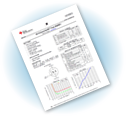A story of effectiveness: Glass in industrial applications

It would be almost impossible to imagine our modern world without glass. The material is as visually striking and complex as it is versatile, from glass microspheres used as fillers to sight glass that protects humans from high-level radiation. Here, Samir Jaber, Technical Content Writer at Matmatch explores some of the impressive uses of glass in industrial applications.
The average person may associate glass with fragility, yet it has many uses in demanding and high temperature industrial applications. Panels, lenses and covers for manufacturing equipment, instrumentation devices, inspection systems and protective eyeglasses are some examples of such applications.
Sight glass is used commonly with manufacturing equipment and instrumentation, typically as a window or transparent glass tube that allows the operator a clear view of what is happening inside a container. Sight glass is commonly favoured over alternatives like plastic for its durability and effectiveness in withstanding hazardous operating conditions.
Sight glass parts take many forms. These include circular fittings or 'view ports', a round piece of glass that is affixed between two flanges and used to verify the stages of a process, inspect process media or observe liquid levels. There are also sight flow indicators that are used to observe the flow of liquids, powders or gases.
As such, sight glass comes in a wide range of materials with a variety of chemical properties. There are several key factors to keep in mind when determining and selecting the appropriate source material - and an increasing wealth of online information to help design engineers choose. For a start, engineers should select durable materials to reduce the chance of component failure.
It’s important to consider the expected maximum operating temperature that, for some types of soft glass like soda-lime silicate, is up to 745°C. For others, such as borosilicate glasses, it can reach above 1400°C. Sudden, rapid and extreme temperature changes should also be considered to assess a glass material’s suitability. For that, engineers should calculate the material’s thermal shock parameter.
Other factors include the glass’s anti-corrosion properties. Caustic or acidic substances may cause sight glass to become 'cloudy', which affects visibility. That also goes for anti-erosion properties to protect from abrasive elements. Designers should use a thick and durable material and ensure that the glass is regularly inspected to preserve its longevity.
Selecting a thick glass is key to withstanding these factors. It is also not uncommon for objects to impact against the sight glass, like dropped tools or waste that is often dispersed on food processing lines.
Challenging environments
A popular material choice of glass for industrial applications is fused silica, otherwise known as fused quartz, which consists of silica in an amorphous - or non-crystalline - form. Fused silica has a three-dimensional structure with several advantages. They include excellent resistance to thermal shock, near-zero thermal expansion and ultraviolet (UV) transparency.
Because of its strength and high melting point, compared with ordinary glass, fused silica is optimal for high temperature environments and rapid temperature changes.
Another popular form of industrial glass is soda-lime silicate. Used in windowpanes and glass containers for the food and beverage industry, its disadvantages include relatively poor resistance to thermal shock, corrosion and abrasion. However, it can be re-softened and re-melted for reuse in multiple applications. Laminated soda lime can be inserted between two or more pieces of glass to bind the layers together and increase its strength. This method is popularly used in the architectural and automotive industries.
Shielded from radiation
Protection from projectile foodstuffs and rapid temperature changes is one thing; but what about shielding humans from radiation?
Schott AG is an international technology group that makes specialty glass and glass ceramics, including glass tubing. Its products also include float glass for windows and display glasses, which are frequently required for high transparency at fluctuating temperatures. Schott has enhanced the neutron attenuation in its glass products for different applications that have medical or nuclear uses. Its R30 glass, for instance, is recommended for medical scan applications.
In the case of two of Schott’s RS glasses, RS 253 G18 and RS 323 G19 in particular, the materials technology specialist dopes the glass types with cerium dioxide. This prevents glass solarisation, otherwise known as 'browning', typically caused by high-energy, radiation-induced ionisation. The glass is also resistant to radiation solarisation.
Small, but strong
The windows of opportunity for industrial glass continue to open up. Take solid glass microspheres, for example, which typically range from 30-250μm in diameter and are helping the industry to achieve new levels of performance and productivity. They are opening up more efficient ways to drill for oil, improve insulation for deep-sea pipelines, and produce paint with cooling properties.
According to the reference book Comprehensive Composite Materials, the chemical composition of solid glass microspheres is generally 72% silicon dioxide (SiO2), 14% sodium oxide, 8% calcium oxide (CaO) and 6% magnesium oxide (MgO). They are produced either from scrap plate glass or bottle glass, or from a mixture of sand or soda ash.
As such, they are nonporous, chemically stable, and provide excellent water and oil resistance. Because they are strong enough to survive processing, solid glass microspheres can be incorporated into a wide range of polymers, as fillers, for density reduction. This results in unique performance and processing advantages.
Seeing is believing
From thick anti-radiation glass to the smallest microspheres, applications for industrial glass are as varied as they are impressive. The onus is on design engineers to understand their potential, and this is where an online materials search database, like Matmatch, can prove integral. Given the exciting possibilities, it is certain that we’ll never have to imagine a world without glass.
Similar articles
More from Matmatch
- Using mushrooms to make packaging materials 26th May 2021
- Materials that could bring life to Mars 28th April 2021
- The key environmental indicators in sustainable material selection 19th February 2021
- Guide to sustainable materials now available 25th January 2021












Write a comment
No comments